 W
WA pig is any of the animals in the genus Sus, within the even-toed ungulate family Suidae. Pigs include domestic pigs and their ancestor, the common Eurasian wild boar, along with other species. Pigs, like all suids, are native to the Eurasian and African continents, ranging from Europe to the Pacific islands. Suids other than the pig are the babirusa of Indonesia, the pygmy hog of Asia, the warthog of Africa, and another genus of pigs from Africa. The suids are a sister clade to peccaries.
 W
WThe Anatolian boar is a subspecies of wild boar endemic to Turkey, Levant, Israel and Transcaucasia. It is likely to be one of the ancestors of today's domestic pigs.
 W
WThe babirusas, also called deer-pigs are a genus, Babyrousa, in the swine family found in Wallacea, or specifically the Indonesian islands of Sulawesi, Togian, Sula and Buru. All members of this genus were considered part of a single species until 2002, the babirusa, B. babyrussa, but following that, was split into several species. This scientific name is restricted to the Buru babirusa from Buru and Sula, whereas the best-known species, the north Sulawesi babirusa, is named B. celebensis. The remarkable "prehistoric" appearance of these mammals is largely due to the prominent upwards incurving canine tusks of the males, which actually pierce the flesh in the snout.
 W
WThe banded pig also known as the Indonesian wild boar is a subspecies of wild boar native to the Thai-Malay Peninsula and many Indonesian islands, including Sumatra, Java, and the Lesser Sundas as far east as Komodo. It is known as the wild boar in Singapore. It is the most basal subspecies, having the smallest relative brain size, more primitive dentition, and unspecialised cranial structure. It is a short-faced subspecies with a white band on the muzzle, as well as sparse body hair, no underwool, a fairly long mane, and a broad reddish band extending from the muzzle to the sides of the neck. It is much smaller than the mainland S. s. cristatus subspecies, with the largest specimens on Komodo weighing only 48 kg.
 W
WThe Beast of Dean is an animal said to live, or to have once lived, in the Forest of Dean, Gloucestershire, England. It was originally thought to resemble a wild boar, but abnormally large in size. At that time of its first sightings, wild boar were extinct in Britain.
 W
WBoar hunting is generally the practice of hunting wild boars, but can also extend to feral pigs and peccaries. A full-sized boar is a large, powerful animal, often having sharp tusks which it uses to defend itself. Boar hunting has often been a test of bravery.
 W
WBoar–pig hybrid is a hybridized offspring of a cross between the Eurasian wild boar and any domestic pig. Feral hybrids exist throughout Eurasia, the Americas, Australia, and in other places where European settlers imported wild boars to use as game animals. In many areas, a variable mixture of these hybrids and feral pigs of all-domesticated original stock have become invasive species. Their status as pest animals has reached crisis proportions in Australia, parts of Brazil, and parts of the United States, and the animals are often freely hunted in hopes of eradicating them or at least reducing them to a controllable population.
 W
WThe North African boar is a smaller subspecies of wild boar native to North Africa including Morocco, Algeria and Tunisia. It is a prey animal for predators such as striped hyenas, African leopards and Barbary lions.
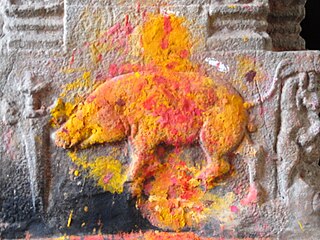 W
WThe wild boar and boar's head are common charges in heraldry.
 W
WThe Bornean bearded pig, also known ambiguously as the bearded pig, is a species in the pig genus, Sus.
 W
WThe Buru babirusa is a wild pig-like animal native to the Indonesian islands of Buru, the two Sula Islands of Mangole and Taliabu. It is also known as the Moluccan babirusa, golden babirusa or hairy babirusa. Traditionally, this relatively small species included the other babirusas as subspecies, but it has been recommended treating them as separate species based on differences in their morphology. As also suggested by its alternative common names, the Buru babirusa has relatively long thick, gold-brown body-hair – a feature not shared by the other extant babirusas.
 W
WThe Celebes warty pig, also called Sulawesi warty pig or Sulawesi pig, is a species in the pig genus (Sus) that lives on Sulawesi in Indonesia. It survives in most habitats and can live in altitudes of up to 2,500 m (8,000 ft). It has been domesticated and introduced to a number of other islands in Indonesia.
 W
WThe Central Asian boar is a small long maned subspecies of wild boar indigenous to Southeastern Iran, Pakistan and Northwest India.
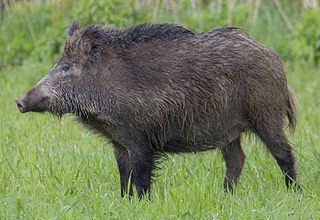 W
WThe Central European boar is a subspecies of wild boar, currently distributed across almost all of mainland Europe, with the exception of some northern areas in both Scandinavia and European Russia and the southernmost parts of Greece. It is a medium-sized, dark to rusty-brown haired subspecies with long and relatively narrow lacrimal bones. In Northern Italy, artificially introduced S. s. scrofa have extensively interbred with the smaller sized indigenous S. s. majori populations since the 1950s.
 W
WThe giant forest hog, the only member of its genus, is native to wooded habitats in Africa and is generally considered the largest wild member of the pig family, Suidae; however, a few subspecies of the wild boar can reach an even larger size. Despite its large size and relatively wide distribution, it was first described only in 1904. The specific name honours Richard Meinertzhagen, who shot the type specimen in Kenya and had it shipped to the Natural History Museum in England.
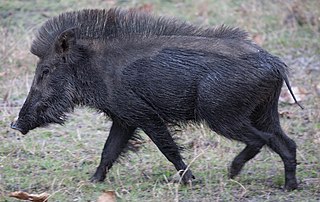 W
WThe Indian boar, also known as the Andamanese pig or Moupin pig is a subspecies of wild boar native to India, Nepal, Burma, western Thailand and Sri Lanka.
 W
WThe Japanese boar, also known as the white-moustached pig, inoshishi (イノシシ), or yama kujira , is a subspecies of wild boar native to all of Japan, save for Hokkaido and the Ryukyu Islands.
 W
WThe Javan warty pig, also called Javan pig, is an even-toed ungulate in the family Suidae. It is endemic to the Indonesian islands Java and Bawean, and is considered extinct on Madura. It is listed as Endangered on the IUCN Red List since 1996.
 W
WThe Judensau at the choir stalls of Cologne Cathedral is a medieval, antisemitic wood carving at the side of one of the seats in the choir of Cologne Cathedral. It was produced between 1308 and 1311. It shows a Jews' sow, a folk art image of Jews in obscene contact with a large female pig, which in Judaism is an unclean animal. It is one of the oldest representations of this theme. Directly beside is another antisemitic motif, which is generally interpreted as an illustration of the blood libel legend. This combination is only known from one other case, a painting from the 15th century at the Old Bridge in Frankfurt.
 W
WThe Maremman boar is a subspecies of wild boar native to Maremma in Central Italy. It is much smaller than the Central European boar and the two subspecies have been interbred on farms.
 W
WMatthew 7:6 is the sixth verse of the seventh chapter of the Gospel of Matthew in the New Testament and is part of the Sermon on the Mount. This verse contains an ambiguous warning about placing "pearls before swine."
 W
WPig milk is milk from pigs, and is typically consumed by piglets. It is similar in composition to cow's milk, though higher in fat and more watery. Pig milk is seldom obtained for human uses and is not considered to be a viable agricultural product. Several attempts have been made to produce pig milk cheese, some of which have been successful.
 W
WThe North Sulawesi babirusa is a pig-like animal native to Sulawesi and some nearby islands in Indonesia. It has two pairs of large tusks composed of enlarged canine teeth. The upper canines penetrate the top of the snout, curving back toward the forehead. The North Sulawesi babirusa is threatened from hunting and deforestation.
 W
WThe northern Chinese boar is a subspecies of wild boar native to China and Vietnam. The subspecies was described by Alphonse Milne-Edwards in 1871. It also occurs in Sichuan. It is likely to be the ancestor of domestic pigs.
 W
WA nose ring is a ring made of metal designed to be installed through the nasal septum of pigs as well as domestic cattle, usually bulls. In pigs, nose rings are alternatively pierced through the rim of the nose. Nose rings are often required for bulls when exhibited at agricultural shows. There is a clip-on ring design used for controlling and directing cattle for handling. Nose rings are used to encourage the weaning of young calves by discouraging them from suckling.
 W
WThe Palawan bearded pig is a pig species in the genus Sus endemic to the Philippines, where it occurs on the archipelago of islands formed by Balabac, Palawan, and the Calamian Islands. It is 1 to 1.6 m in length, about 1 m (3.3 ft) tall and weigh up to 150 kg (330 lb).
 W
WPhacochoerus is a genus in the family Suidae, commonly known as warthogs. It is the sole genus of subfamily Phacochoerinae. These pigs live in open and semi-open habitats, even in quite arid regions, in sub-Saharan Africa. The two species were formerly considered conspecific under the scientific name Phacochoerus aethiopicus, but today this is limited to the desert warthog, while the best-known and most widespread species, the common warthog is Phacochoerus africanus.
 W
WPhacochoerini is a tribe of even-toed ungulates which encompasses the warthogs.
 W
WThe Philippine warty pig is one of four known species in the pig genus (Sus) endemic to the Philippines. The other three endemic species are the Visayan warty pig, Mindoro warty pig and the Palawan bearded pig, also being rare members of the family Suidae. Philippine warty pigs have two pairs of warts, with a tuft of hair extending outwards from the warts closest to the jaw. It has multiple native common names, but it is most widely known as baboy damo in Tagalog.
 W
WPig Beach located on Big Major Cay is a beach on an uninhabited island located in Exuma, the Bahamas. The island takes its unofficial name from the fact that it is populated by a colony of feral pigs which live on the island. It has become a tourist attraction in modern times.
 W
WA pig toilet is a simple type of dry toilet consisting of an outhouse mounted over a pigsty, with a chute or hole connecting the two. The pigs consume the feces of the users of the toilet, as well as other food.
 W
W"Piggate" refers to an uncorroborated anecdote that during his university years former British Prime Minister David Cameron inserted his penis and/or testicles into a dead pig's mouth as part of an initiation ceremony for the Piers Gaveston Society at Oxford University. The anecdote was reported by Michael Ashcroft and Isabel Oakeshott in their unauthorised biography of Cameron, Call Me Dave, attributing the story to an anonymous Member of Parliament who was a "distinguished Oxford contemporary" of Cameron's. Extracts from the book were published in the Daily Mail on 20 September 2015, prior to its publication.
 W
WThe Pigsty is a folly located next to Fyling Hall School, near Robin Hood's Bay, North Yorkshire, England. It is a Grade II* listed wooden building that was once a functioning home for pigs. It is now operated by the Landmark Trust as a holiday home.
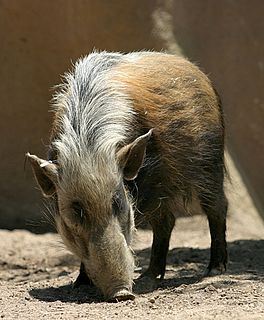 W
WPotamochoerini is a tribe of even-toed ungulates which encompasses the giant forest hogs and the river pigs.
 W
WPotamochoerus is a genus in the pig family (Suidae). The two species are restricted to sub-Saharan Africa, although the bushpig, possibly due to introduction by man, also occurs in Madagascar and nearby islands. Early in the 20th century, there were considered to be as many as five different species within the genus. These were gradually consolidated, until, in the 1970s, it was generally agreed that all were representatives of just a single species. The bushpig was again recognised as a separate species from about 1993.
 W
WThe pygmy hog is a suid native to alluvial grasslands in the foothills of the Himalayas at elevations of up to 300 m (980 ft). Today, the only known population lives in southern Bhutan and in Assam, India. As the population is estimated at less than 250 mature individuals, it is listed as Endangered on the IUCN Red List.
 W
WSuidae is a family of artiodactyl mammals which are commonly called pigs, hogs or boars. In addition to numerous fossil species, 18 extant species are currently recognized, classified into between four and eight genera. Within this family, the genus Sus includes the domestic pig, Sus scrofa domesticus or Sus domesticus, and many species of wild pig from Europe to the Pacific. Other genera include babirusas and warthogs. All suids, or swine, are native to the Old World, ranging from Asia to Europe and Africa.
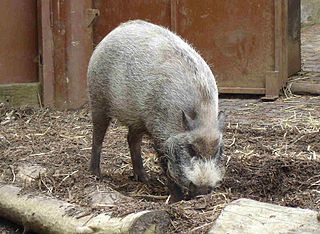 W
WSuinae is a subfamily of artiodactyl mammals that includes several of the extant members of Suidae and their closest relatives—the domestic pig and related species, such as babirusas. Several extinct species within the Suidae are classified in subfamilies other than Suinae. However, the classification of the extinct members of the Suoidea-the larger group that includes the Suidae, the peccary family (Tayassuidae), and related extinct species—is controversial, and different classifications vary in the number of subfamilies within Suidae and their contents. Some classifications, such as the one proposed by paleontologist Jan van der Made in 2010, even exclude from Suinae some extant taxa of Suidae, placing these excluded taxa in other subfamilies.
 W
WA pig is any of the animals in the genus Sus, within the even-toed ungulate family Suidae. Pigs include domestic pigs and their ancestor, the common Eurasian wild boar, along with other species. Pigs, like all suids, are native to the Eurasian and African continents, ranging from Europe to the Pacific islands. Suids other than the pig are the babirusa of Indonesia, the pygmy hog of Asia, the warthog of Africa, and another genus of pigs from Africa. The suids are a sister clade to peccaries.
 W
WThe Taihu pig is a domestic breed of pig from the narrow region of mild sub-tropical climate around the Lake Tai region in the lower Yangtze River Valley of China. The breed is a large one, black in colour with a heavily wrinkled face. It has a large head with a broad forehead and large folded ears. The breed has a number of divisions, classified by some authors as strains and by others as separate breeds.
 W
WTail biting in pigs is an abnormal behavior whereby a pig uses its teeth to bite, chew or orally manipulate another pigs's tail. Tail biting is used to describe a range in severity from light manipulation of the tail to physically harming the tail, causing infection, amputation or even harming areas surrounding the tail. Tail biting typically occurs under the following conditions: indoor facility with a high density of pigs housed in a confined area ; lack of a substrate material; poor ventilation system, or poor feed quality and accessibility.
 W
WThe Togian babirusa, also known as the Malenge babirusa, is the largest species of babirusa. It is endemic to the Togian Islands of Indonesia, but was considered a subspecies of Babyrousa babyrussa until 2002. Compared to the better-known north Sulawesi babirusa, the Togian babirusa is larger, has a well-developed tail-tuft, and the upper canines of the male are relatively "short, slender, rotated forwards, and always converge".
 W
WThe Visayan warty pig is a critically endangered species in the pig genus (Sus). It is endemic to six of the Visayan Islands in the central Philippines. It is known by many names in the region with most translating into 'wild pig': baboy ihalas, baboy talonon, and baboy sulop
 W
WWar pigs are pigs reported to have been used in ancient warfare as military animals, mostly as a countermeasure against war elephants.
 W
WPhacochoerus is a genus in the family Suidae, commonly known as warthogs. It is the sole genus of subfamily Phacochoerinae. These pigs live in open and semi-open habitats, even in quite arid regions, in sub-Saharan Africa. The two species were formerly considered conspecific under the scientific name Phacochoerus aethiopicus, but today this is limited to the desert warthog, while the best-known and most widespread species, the common warthog is Phacochoerus africanus.
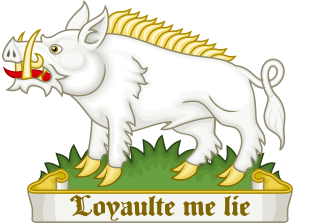 W
WThe White Boar was the personal device or badge of the English King Richard III of England, and is an early instance of the use of boars in heraldry.